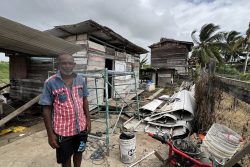Dear Editor,
I will give a brief overview of the treatment process used at the water facility I manage. Water treatment: Our raw water comes from the Biscayne Aquifer, approximately 150 feet underground. It is a shallow layer of highly permeable limestone under a portion of South Florida. It underlies Broward County, Miami-Dade County, Monroe County, and Palm Beach County, a total of about 4,000 square miles (10,000 km2). The raw water is pumped into a clarifier (the clarifier works by permitting the heavier and larger particles at the bottom of the clarifier). The particles then form a bottom layer of sludge requiring regular removal and disposal. Clarified water then proceeds through several more steps before being sent for storage and use.
Clarified water is processed through a nanofiltration system. (Nanofiltration (NF) is a membrane-based filtration process that uses pressure to separate solutes from a liquid. It’s a common water purification technique, and is also used in food processing, wastewater treatment, and other industries). Nanofiltration also removes pharmaceuticals and other contaminants from water. After the nanofiltration process, the water is aerated, and treated to kill bacteria making it safer for human consumption. The treated water is then stored and pumped to end users. The sludge from the clarifier is pumped out and sent to the wastewater treatment plant for processing. A few parameters that has to be met before the water is sent for consumption includes: pH, dissolved oxygen, hardness, conductivity, alkalinity, nitrate, total dissolved solids (TDS), chloride, fluoride, calcium, magnesium, iron, and various forms of nitrogen (nitrite, nitrate).
Wastewater treatment. Wastewater flows to our plant from many sources, households and commercial facilities being the primary discharge sources. Wastewater from households and other sources are pumped into lift stations strategically placed throughout the city, then pumped to the wastewater treatment plant. At the wastewater treatment plant, debris and grit (sand and other settleable solids) are separated through a screening process (this is done to protect equipment and make the treatment process more efficient). Air is introduced into the waste stream to alleviate odor and then the wastewater goes through a biological treatment process (no chemical is used in this treatment process). At the end of the biological process, the digested solids are separated from the liquid through a centrifuge (basically a big washing machine on spin cycle). The solids are hauled away by trucks to be used as fertilizer in fields and the liquid is pumped 2,800 feet below ground through a series of deep injection well pumps.
Some of the effluent from the waste treatment process goes through additional treatment and is pumped out to residents as reuse water (reuse water is for watering lawns and other irrigation purposes). It is NOT for drinking or other human uses. The above is a just a basic overview of the process that is strictly monitored and have rigid checks and balances in place to ensure adherence to the strictest standards established by the Florida and US Departments of Environmental Protection Agencies. There are fines and jail time involved in falsifying reports and or not adhering to procedures that can put the public’s health at risk. Hope this brief overview help to provide a basic understanding of the treatment process.
Sincerely
Ayaz Mohamed
Fort Lauderdale
Florida





